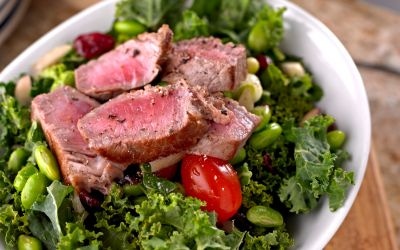Marketing to the paleo consumer
Modern day consumers demand constant access to information and that information influences consumer buying decisions.
April 18, 2013

Todays consumers have constant access to information, and they take advantage it, especially when buying edibles. Company information, news stories and customer reviews all play into the buying decision. Label readers are everywhere, but the rise in one specific type, the Paleo customer, presents new and unique challenges and opportunities for food and beverage companies. The Paleo consumer is someone who follows what is known as the Paleolithic Diet" (aka, the Paleo Diet" or Caveman Diet"), which is more of a lifestyle than diet. Paleo consumers only eat specific, whole, unprocessed foods that could be easily found by our ancestors living 2 million to 10,000 years ago during the Paleolithic Era. These foods include meats, fresh fruits, vegetables, nuts and seeds, which could have been hunted or gathered in the wild. The Paleo consumer avoids anything that is considered artificial or a product of the agricultural revolution, including legumes, grains, rice, processed foods and sugars, dairy and starches. The idea is simple: eat natural, nutrient-rich foods and reap a number of benefits, ranging from increased energy, stable blood sugar and reduced inflammation in joints to a lean physique.
Who lives the paleo lifestyle?
Men and women of all ages embrace the Paleo lifestyle all over the world. The rising concerns of obesity and excessive food production have made people more aware of what they eat and drink. The Paleo diet offers easily understood tenets and helps people make diet choices that stick with wholesome, nutritious foods and beverages.
Much of the Paleo population is comprised of the CrossFit community, a rapidly growing fitness movement. For this group, the Paleo diet is the prescribed diet listed on the CrossFit website and is promoted in the more than 6,000 affiliate gyms around the world.
The Paleo consumer is a highly critical label reader who analyzes everything that goes into their body. In general, they tend to avoid items in the store that have labels. They stay informed about health and nutrition news, and are continually learning more as new studies and ideas arise.
Paleo followers view their diet as preventive health care. They believe eating whole, natural, unprocessed foods and staying active will allow them to avoid future illness by taking care of their bodies now through nutrition and exercise. Because they see their diet as the driving force in overall health, they spend extra money to buy organic fruits and vegetables, grass-fed beef and free range chicken. They believe eating the most wholesome foods is a way of saving money in the future by preventing and avoiding expensive medications or health care bills.
Marketing to the paleo consumer
When the Paleo community looks at a product, they will go straight for the nutrition panel and dissect the ingredients. They look for recognizable ingredients, especially whole foods and vitamins. They will immediately avoid products with preservatives or ingredients that sound like they were made in a lab.
They are not afraid to ask questions, and they will want to be sure that a company has done its research and due diligence. Social media, discussion boards and online marketplaces such as Amazon allow consumers to voice their opinions, ask questions and request more information. Any company looking to market to the Paleo community should be ready to answer questions and make sure that each employee knows the product, sourcing locations, and manufacturing processes inside and out.
The key idea behind the Paleo lifestyle calls for people to eat simple, natural foods that our ancestors could find. Its easy to see that any product that has a long list of ingredients will be met with initial skepticism because it will make the product seem less like something that could have been hunted or gathered. There is some leeway in the food and beverage market because convenience still matters. A caveman wouldnt have access to packaged beverages or even bottled water, but these are conveniences we have in the modern world and convenience will count.
The process used to make products is just as important as the ingredients. This is a very well-informed customer community, and they will scour the Internet for information on how a product was made. It can have all the right ingredients and still be rejected if the product is overly processed or heat pasteurized. New processing techniques like high pressure pasteurization (HPP) and cold filling are preferred. Raw products are preferred, but safety and stability remain important. Paleo consumers are aware of most processing techniques, and will favor minimal or no processing to ensure that nutritional value is not lost to heating. Being honest and straightforward with the most minimal processing possible and proudly displaying this on the label will help communicate and connect.
Agriculture has led to the dominance of the refined carbohydrate. A key tenet of the Paleo diet is stabilizing blood sugar levels to minimalize insulin spikes. The nutrient density and sugar levels are often the factors that define foods as allowed" by the Paleo diet. Most Paleo consumers try to avoid any added sugars, but practicality opened the door for natural sweeteners such as honey, agave and stevia. The best practice when it comes to any sweetener is to use them in moderation. A little sweetener can go a long way to create a great-tasting product, but keep the nutrition facts in mind. The Paleo community is less likely to count calories, but they wont buy a product deemed unhealthy by conventional wisdom just because it meets their standards.
Where are paleo consumers?
Theyre everywhere. You probably know a few yourselves. Paleo consumers are easy to find. They tend to shop at local farmers markets and in natural food stores such as Whole Foods Market, Sprouts and New Seasons. When marketing to the Paleo community, focus on stores that sell high-quality, natural and organic foods. A stores reputation will go a long way. Stores such as Whole Foods Market, which stake their reputation on providing only the highest quality foods and drinks, will likely attract Paleo eaters. Targeting the most popular and well-respected blogs, magazines, newsletters and websites providing Paleo or general health and nutrition news are also a great place to start. The fact that the Paleo consumer is well informed makes them a source of information within their social spheres, and that is also what makes them such a valuable customer: if they like your product, they will recommend it to all of their friends, and their friends will listen.
Joe Siler, co-founder/sales manager, Amara Beverage Company, grew up in Novato, CA, and is a CrossFit Rx'er and health enthusiast. After graduating from the University of Notre Dame with a degree in accounting, his interest in how the body functions brought him to Portland, OR, where he earned a degree in biology from Concordia University.
About the Author(s)
You May Also Like




.png?width=800&auto=webp&quality=80&disable=upscale)